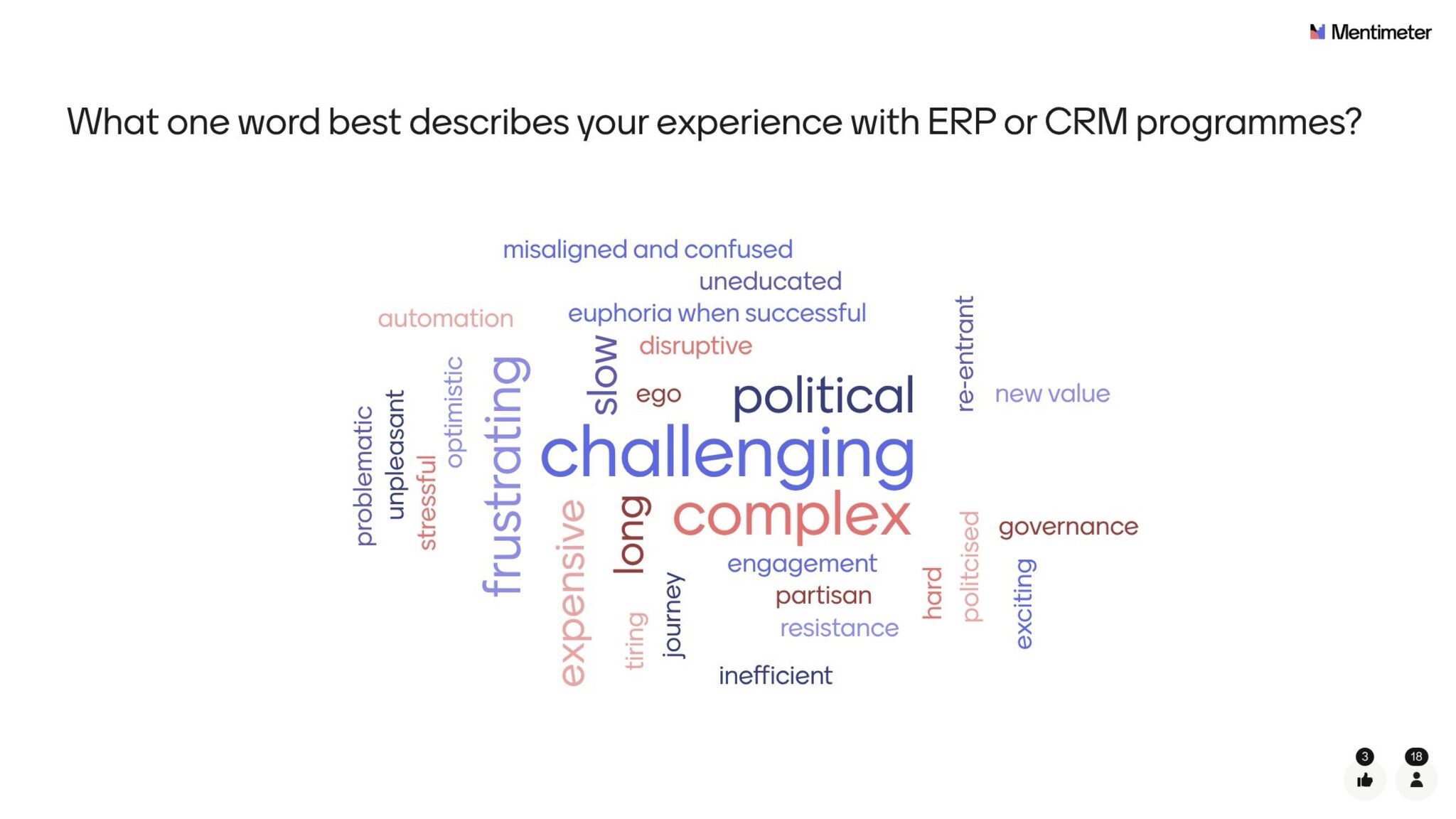Last week, Sullivan & Stanley hosted a virtual event for all of our client communities exploring one of the most persistent challenges in transformation: why ERP and CRM systems fail. The session was co-hosted by myself and Peter Tingay, both Managers at S&S, along with Chris Croxford, a valued member of our Change Society.
When we asked participants to describe their ERP and CRM experiences in one word, the responses painted a vivid picture: “challenging,” “political,” “complex,” “disruptive,” and “partisan” dominated the screen. Yet buried among these was a telling reminder: “euphoria when successful.”
This captures the entire dilemma. ERP and CRM transformations can be genuinely transformational, but most struggle to deliver their original vision. And the difference between success and failure isn’t usually the technology. It’s everything else.

The ten critical failure points
We identified ten recurring patterns that derail ERP and CRM implementations. When we asked our participants where they see the greatest risk to success, change resistance and stakeholder misalignment topped the list—validating that these aren't technical problems, they're human ones:
- Underestimating complexity: Oversimplifying system integration or customisation challenges leads to unexpected delays and failures. The technology is rarely the main challenge, it's everything else.
- Lack of clear objectives: Vague goals or undefined success metrics lead to misaligned efforts. "Better processes" isn't a goal; "reducing order processing time by 30%" is.
- Poor stakeholder engagement: Limited involvement leads to misaligned expectations, risking solution rejection. Users don't resist change—they resist being changed.
- Insufficient focus and time: Due to unclear vision and misunderstanding of benefits, teams become distracted or disengaged, often treating the project as side-of-desk work.
- Disconnected technology and business delivery: This leads to poor decisions and unnecessary solution rework. When business and IT teams aren't aligned, everyone loses.
- Failure to align with business processes: Implementing systems that don't reflect how the business actually operates creates friction from day one.
- Business not ready to transition: Missed opportunities to start pre-work such as data cleansing and policy changes delay progress significantly.
- Change resistance: Individual resistance isn't anticipated or managed, causing adoption issues that can persist long after go-live.
- Incomplete transformation: Clinging to legacy activities results in missed benefits and wasted effort. You can't innovate by keeping one foot in the past.
- Lack of clear business sponsorship: Caused by misunderstanding of the project's value, leading to lack of leadership support when things get challenging.
So how can we mitigate against these failure points?
After mapping out the key reasons why ERP and CRM initiatives so often go off track, we turned our attention to something more useful: what can we actually do about it? The session was run in a Lean Coffee format, meaning participants brought their own questions and voted on what they most wanted to explore. The top question was one that gets to the heart of transformation success: what really drives system adoption?
Adoption starts before Go-Live
The top-voted question was: “What drives adoption of systems?” Our collective answer was clear - you don’t start driving adoption at go-live. You start at day zero. Adoption isn’t a final phase; it’s a continuous, proactive process that runs throughout your transformation journey.
We explored the building blocks of successful adoption, each designed to engage people, reduce resistance, and build momentum:
- Stakeholder analysis & engagement: Identify and involve the right people early. Don’t just inform them — enlist them as co-creators and champions.
- Training needs analysis & role-based enablement: Design training that fits how people actually work. One-size-fits-none.
- Success metrics & adoption KPIs: Measure what matters. Track adoption, not just usage, and refine based on real feedback.
- Communication strategy: Clear, consistent messaging, focused on what’s changing, why, and how it helps, is essential to alignment.
- Change champion networks: Equip a network of trusted voices to lead from within. Peer influence often outpaces leadership mandates.
- Post-Go-Live reinforcement & behavioural nudges: Learning doesn’t stop at launch. Reinforce change through feedback loops, coaching, and nudges embedded into day-to-day work.
- Readiness Assessment & Change Impact Analysis: Anticipate disruption by understanding where and how change will land hardest, and prepare accordingly.
- 90-day Mission cycles with embedded learning: Deliver, train, and refine in tight feedback loops that suit how teams naturally operate.
- Continuous improvement & capability uplift: Make the transformation stick by building the capability to adapt and improve, long after consultants have left.
The result is change that sticks. People are informed, engaged, and equipped to thrive in the new ways of working. Adoption isn’t an accident, it’s an outcome of deliberate, people-centered design.
Delivering early and continuous value

The second hottest topic focused on how can transformations deliver early and continuous value. This is where we heard some of the most relatable , and painful war stories. One participant summed it up perfectly:
“The phrase ‘boil the ocean’ comes to mind — we were just doing too much. The third time round, we started differently, with bite-sized chunks.”
This shift in mindset from "big bang" to incremental value delivery is what separates successful transformations from stalled ones.
Common pitfalls:
- Value perceived only at go-live
- Early business benefits sacrificed for technical readiness
- Dual-running systems confusing users and stalling adoption
- Technology delivered without behavioural and process alignment
Best practices to drive early value:
- Shift behaviours early: Change language, roles, and expectations before the system arrives. One example shared: a CRM team saw 40% adoption on day one in areas where early behaviour change had been embedded, compared to 0.2% elsewhere.
- Deliver real outcomes early: Release “minimum viable” capabilities that solve real user problems. Avoid perfectionism go for progress.
- Assign clear value owners: Appoint leaders who are directly accountable for realising early value, not just ticking off project milestones.
Long lead times kill belief. Early wins build trust, motivation and momentum.
Milestones vs. outcomes: Don’t fall into the trap
Our final discussion touched a common but subtle trap: focusing too heavily on milestones at the expense of outcomes. Milestones matter. They create rhythm, urgency and accountability. But milestones are not the goal they’re just checkpoints. After all, you can deliver every milestone on time and still fail.
The group aligned on a nuanced takeaway: you need both milestones and outcomes. Milestones track progress; outcomes deliver value.
Build a balanced delivery approach:
- Use milestones for planning and progress tracking.
- Define outcomes as the real measures of success - improvements in process, behaviour, or business performance.
- Align your governance, reporting and leadership conversations around both.
ERP and CRM programmes are among the most complex transformations an organisation can take on. But complexity isn’t what causes failure — misalignment, unclear ownership and people being left behind do.
At Sullivan & Stanley, we’ve helped organisations navigate exactly these challenges. In one case, after years of stalled progress, we stepped in to reframe the approach. The results speak for themselves: the remaining 45% of the business was implemented in just over 18 months, with a 55% budget reduction, from £22 million to under £10 million.
With the right rhythm, the right focus on people, and early momentum, transformation doesn't have to be painful, it can be powerful.

